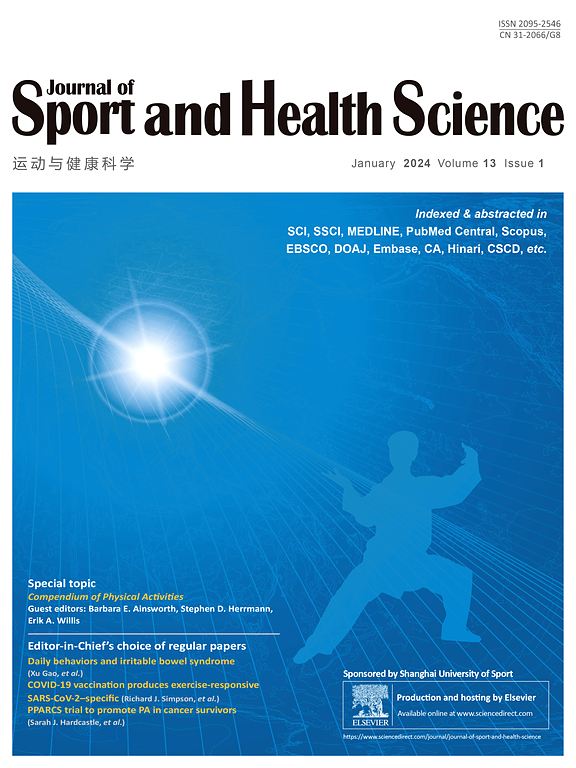Prolonged passive vibration of Achilles and patellar tendons decreases effort perception during subsequent cycling tasks.
IF 10.3
1区 医学
Q1 HOSPITALITY, LEISURE, SPORT & TOURISM
引用次数: 0
Abstract
BACKGROUND The perception of effort is a key determinant of endurance performance and a barrier to physical activity in inactive populations. From a neurophysiological viewpoint, effort perception is thought to arise from the brain processing of an efference copy of the motor command in sensory areas. However, recent research suggests that feedback from muscle spindles plays a significant role in this perception. In this study, tendon vibration protocols were employed to attenuate sensory feedback during subsequent cycling exercises. The aim was to assess whether vibration would increase cycling power output, muscle activation, and heart rate at fixed perceived effort intensities. METHODS Fifteen healthy young participants completed 2 experimental visits (vibration and sham). In each visit, participants performed two 3-min cycling bouts, 1 at a moderate perceived effort intensity and 1 at a strong perceived effort intensity, before (pre) and after (post) an actual or a sham vibration protocol. Vibration was applied bilaterally on the patellar and Achilles tendons for 10 min. Power output, heart rate, and vastus lateralis electromyography (VL EMG) were recorded and averaged for each bout. Absolute values as well as relative change (%) between pre and post conditions were compared across sham and vibration conditions. RESULTS At moderate perceived effort, power output, heart rate, and VL EMG increased post-vibration compared to pre-vibration (p < 0.05), while no difference was observed in the sham condition. At strong perceived effort, power output and VL EMG decreased post-sham (p < 0.05) but remained unchanged post-vibration. Moreover, the relative change between pre and post conditions was significantly higher in the vibration conditions compared to the sham condition for all variables. CONCLUSION This study shows that tendon vibration reduces effort perception during subsequent cycling bouts. This effect is likely a consequence of vibration-induced reduction in muscle spindle reafferent signaling to the brain, but this mechanism remains to be further elucidated. From an applied perspective, these findings highlight tendon vibration as a promising tool for enhancing physical activity engagement.跟腱和髌骨肌腱的长时间被动振动会在随后的循环任务中降低力感。
背景努力感是不运动人群耐力表现的关键决定因素,也是身体活动的障碍。从神经生理学的观点来看,努力知觉被认为是由大脑在感觉区域处理运动命令的一个输出拷贝而产生的。然而,最近的研究表明,肌肉纺锤波的反馈在这种感知中起着重要作用。在这项研究中,肌腱振动方案被用来减弱在随后的循环运动中的感觉反馈。目的是评估振动是否会在固定的感知强度下增加循环功率输出、肌肉激活和心率。方法15名健康青年受试者完成两次实验访视(振动和假手术)。在每次访问中,参与者在实际或假振动协议之前(前)和之后(后)进行两次3分钟的骑行,一次在中等感知努力强度下,一次在强烈感知努力强度下。在双侧髌骨和跟腱上施加振动10分钟。记录每轮功率输出、心率和股外侧肌电图(VL EMG)并取平均值。在假手术和振动条件下,比较了前后条件之间的绝对值和相对变化(%)。结果与振动前相比,振动后的中度知觉力、功率输出、心率和VL肌电均有所增加(p < 0.05),而假手术组无显著差异。在强烈的知觉努力下,假手术后功率输出和VL肌电图下降(p < 0.05),但在振动后保持不变。此外,在所有变量中,振动条件下前后条件之间的相对变化明显高于假性条件。结论:本研究表明,肌腱振动降低了随后的骑行过程中的努力感。这种效应可能是振动诱导的肌纺锤体回传信号减少的结果,但这一机制仍有待进一步阐明。从应用的角度来看,这些发现突出了肌腱振动作为一种有前途的工具,以加强身体活动的参与。
本文章由计算机程序翻译,如有差异,请以英文原文为准。
求助全文
约1分钟内获得全文
求助全文
来源期刊

Journal of Sport and Health Science
SPORT SCIENCES-
CiteScore
18.30
自引率
1.70%
发文量
101
审稿时长
22 weeks
期刊介绍:
The Journal of Sport and Health Science (JSHS) is an international, multidisciplinary journal that aims to advance the fields of sport, exercise, physical activity, and health sciences. Published by Elsevier B.V. on behalf of Shanghai University of Sport, JSHS is dedicated to promoting original and impactful research, as well as topical reviews, editorials, opinions, and commentary papers.
With a focus on physical and mental health, injury and disease prevention, traditional Chinese exercise, and human performance, JSHS offers a platform for scholars and researchers to share their findings and contribute to the advancement of these fields. Our journal is peer-reviewed, ensuring that all published works meet the highest academic standards.
Supported by a carefully selected international editorial board, JSHS upholds impeccable integrity and provides an efficient publication platform. We invite submissions from scholars and researchers worldwide, and we are committed to disseminating insightful and influential research in the field of sport and health science.
 求助内容:
求助内容: 应助结果提醒方式:
应助结果提醒方式:


